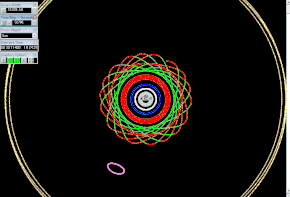 Rotating frame animation in reference to Jupiter. Each frame 81 years. | |
| Discovery [1] | |
|---|---|
| Discovered by | N. S. Chernykh |
| Discovery site | Crimean Astrophysical Obs. |
| Discovery date | 11 October 1980 |
| Designations | |
| (5222) Ioffe | |
Named after | Abram Ioffe (Soviet physicist)[2] |
| 1980 TL13 · 1978 LP 1989 TG1 | |
| main-belt [1][3] · (middle) Pallas [4] | |
| Orbital characteristics [1] | |
| Epoch 16 February 2017 (JD 2457800.5) | |
| Uncertainty parameter 0 | |
| Observation arc | 64.08 yr (23,405 days) |
| Aphelion | 3.1728 AU |
| Perihelion | 2.3788 AU |
| 2.7758 AU | |
| Eccentricity | 0.1430 |
| 4.62 yr (1,689 days) | |
| 172.25° | |
| 0° 12m 47.16s / day | |
| Inclination | 34.539° |
| 220.66° | |
| 331.02° | |
| Physical characteristics | |
| Dimensions | 17.989±0.093 km[5] 21.73 km[6] |
| 19.4 h[6] | |
| 0.1031[6] 0.1463±0.012 0.202±0.041[5] | |
| B (SMASSII)[1] | |
| 11.4[1] | |
5222 Ioffe, provisional designation 1980 TL13, is a rare-type carbonaceous Palladian asteroid from the central region of the asteroid belt, approximately 18 kilometers in diameter. It was discovered on 11 October 1980, by Soviet astronomer Nikolai Chernykh at the Crimean Astrophysical Observatory in Nauchnyj, Crimea.[3] It is the largest of the Palladian asteroids apart from Pallas itself.
- ^ a b c d e Cite error: The named reference
jpldatawas invoked but never defined (see the help page). - ^ Cite error: The named reference
springerwas invoked but never defined (see the help page). - ^ a b Cite error: The named reference
MPC-Ioffewas invoked but never defined (see the help page). - ^ Cite error: The named reference
Ferretwas invoked but never defined (see the help page). - ^ a b Cite error: The named reference
Masiero-2014was invoked but never defined (see the help page). - ^ a b c Cite error: The named reference
lcdbwas invoked but never defined (see the help page).